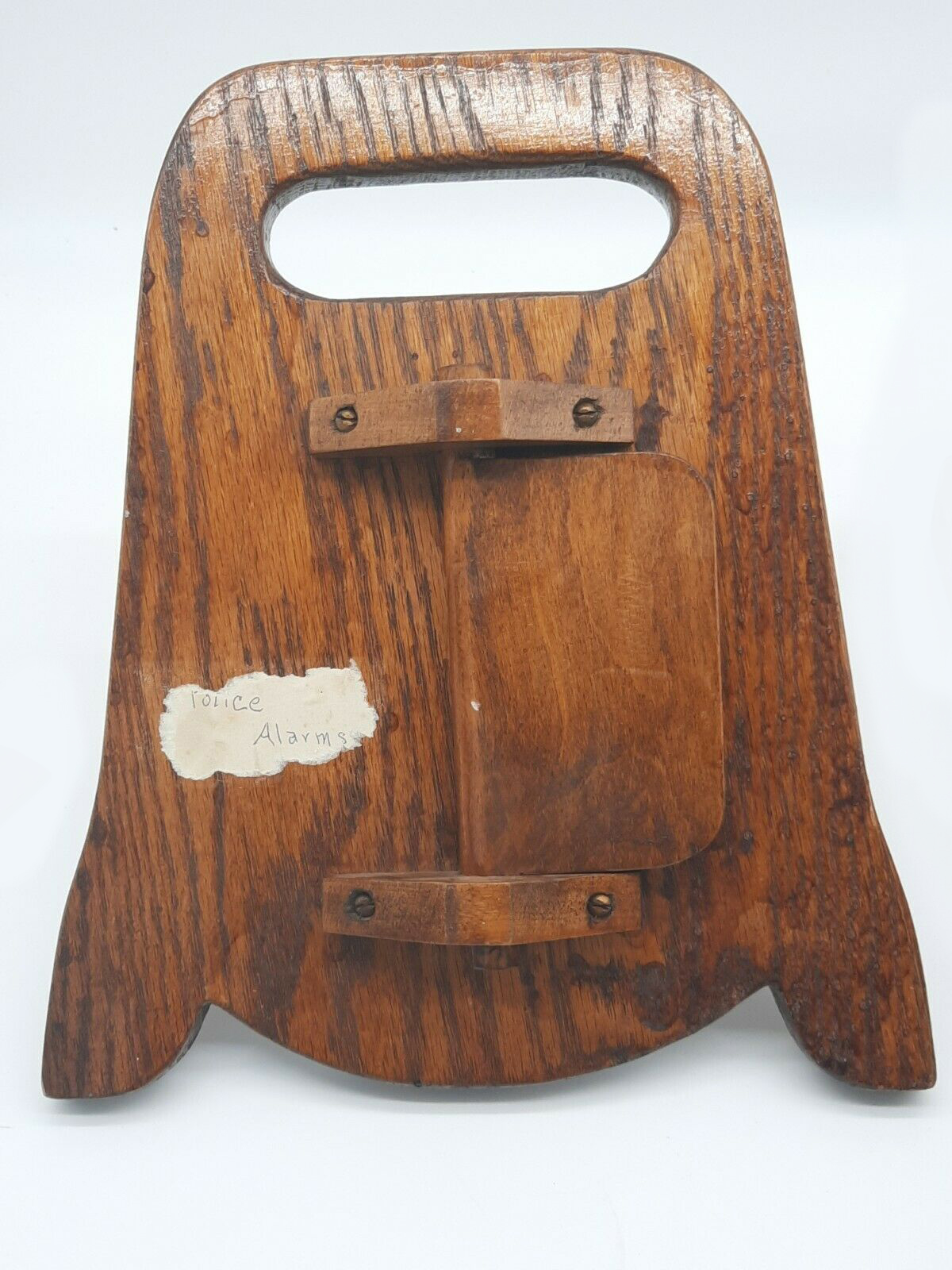Rattles and Billy Clubs
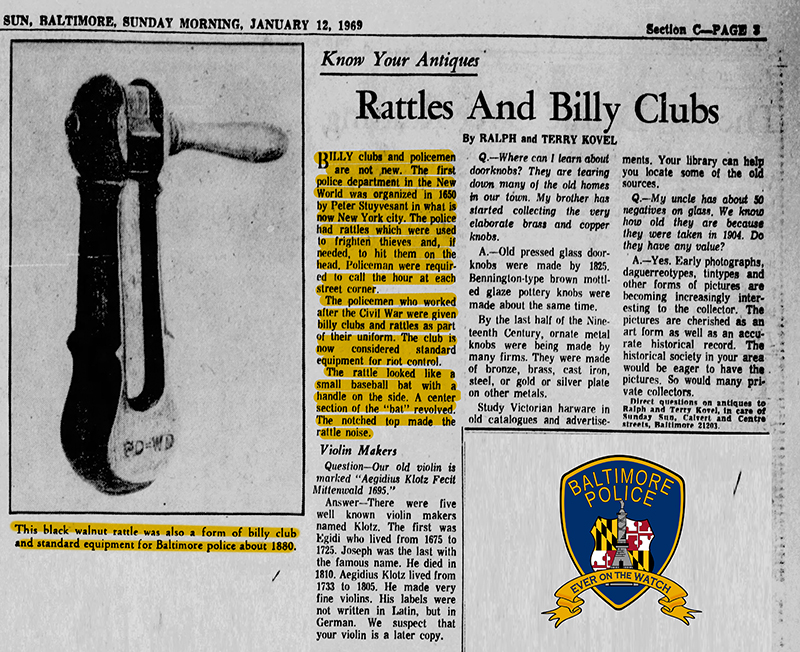 Click HERE or on the Article Above to see full size page
Click HERE or on the Article Above to see full size page
The Police Rattle seen in this Sun Paper article above is a Police Department Rattle from our Western District

A little easier to read, this 1969 article about the Police Rattle / Billy Club
Click the above article or HERE to see full size news clipping
 Patrolman John H Hand
Patrolman John H Hand
Click HERE to visit Patrolman Hand's Page
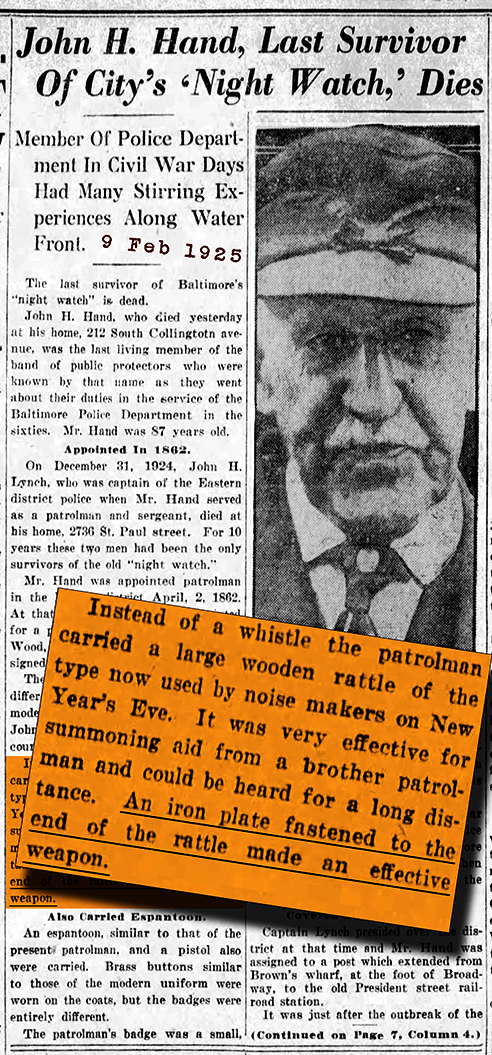 This is a 1925 newspaper article about Patrolman John H. Hand
This is a 1925 newspaper article about Patrolman John H. Hand
The article describes this rattle, which was provided to us by his family
Click HERE to see full size article

Click HERE or Article Above

Click HERE or Article Above
 From Rattle Watch to Batons
From Rattle Watch to Batons
To Read The Above Article Click HERE or Click on the Article

Baltimore Police Rattles in use
"Officers Jamison and Huggins, one of whom sprang his rattle in advance of Corrie, which so alarmed him, that he slackened his pace and was easily captured."

CLICK HERE FOR AUDIO
On this day in Baltimore Police History 5 Nov, 1858 we lost our brother Police Officer Robert M. Rigdon in an Assassination by Gunfire – From the Baltimore Sun paper - The Examination before the Mayor – Investigation and Verdict of the Coroner’s Jury – The Excitement and Incidents of the Tragedy. – the killing of Robert M. Rigdon, an officer of the Western district, who was assassinated in the bosom of his family, at 468 West Baltimore street, the night previous, out of revenge for his testimony delivered in the case of Gambrill, concluded in Criminal Court on the same afternoon for the murder of officer Benjamin Benton, a brother officer of the deceased… The assassination appears to have been one of deliberate premeditation. Officer Rigdon, after answering roll call at the station house on Green street, retired into the privacy of his home. During the evening, and while Mr. Rigdon was in the back-room of his dwelling, a man (since recognized as Peter Corrie) entered the store-room, which is in the front part of the house, and looked at some undershirts and other articles displayed. In the store he conducted himself like a drunken man, but that was evidently feigned. His actions becoming repulsive to Mrs. Rigdon and a female attendant, she called on her husband to eject him from the premises. Fearful that the thing was a ruse to draw him within the reach of his enemies, Rigdon hesitated, and said to his wife, who stood in the doorway leading to the storeroom, “I don’t attend the store – tell him to go out,” or words to that effect. At that moment, while resting with his elbow against the mantel of the fireplace, where he had laid his pistol belt, the weapon of the crouching assailant in his rear was fired through the little window, which opens into the yard from the sitting room. Rigdon, who, from the position of the mantel, must have been but three or four feet distant from the weapon, received five slugs in his back, near the left side. His only exclamation was, “My God! I’m shot!” and attempted to reach for the sofa, but sank on the floor and died after heaving an audible groan. Persons passing upon the street and the residents alarmed by the shot, hastened into the house, where they stood horrified and trembling at the deed of blood before them, for a moment transfixed and unable to act. His wife is said to have acted heroically, and neither shrieked nor fainted, but recited all with coolness and self-possession which was remarkable. Officer J. Cook being in the vicinity hastened in the direction of the shot, and fell upon Peter Corrie as he was running away from the alley of Rigdon’s house.

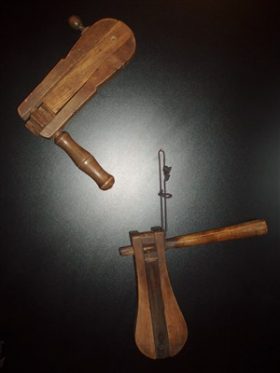
Wooden Ratchet Noisemaker & Police Rattle
The top noisemaker is a "Ratchet Noisemaker" the bottom is a "Policeman's Rattle"
The Rattle, was used as both a tool to communicate with other officers to call for help, but in the meantime while fighting off a violent offender, it could be turned around in the hand and used as an impact weapon to fight off danger. In the two Rattles seen in the photo above the top is more of a toy, than policeman's Rattle, this can bee seen in the shape, the police version was designed in a way that would allow the officer to more easily wrap his hand around the base between the, "Ratchet" end, and the portion that secures the "Clappers." The one on the bottom of the two in the pic above looks more like a lightbulb, whereas the other has rounded edges but wouldn't allow for an officer to get a good secure grip. When using the Police Rattle as a weapon, it would be held in the officers fist with the rounded end (the part where the clappers are secured to the Rattle coming out from the palm end of the officers fist, making what is known as a, "Hammer Punch" more effect. When I mention the Hammer Punch, I should point out, that I learned of this use, I was told it was a "Backfist" weapon, in looking up the backfist, I found it to be what is called today, a Hammer Punch, or Hammer Fist.


This shows how it would be held, swung down hitting with the end that has the screw like a karate chop to stop an attacker, for an impact weapon, it was nice, but nothing beats the Espantoon for a multipurpose law enforcement tool.
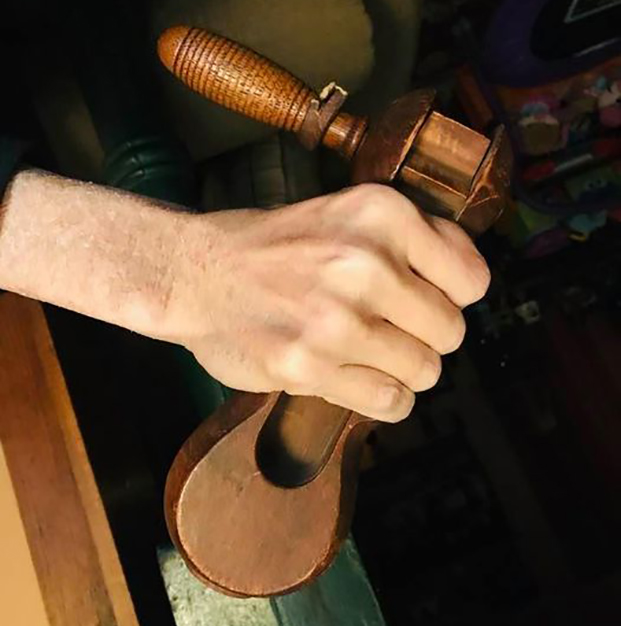
A different angle of how the Police Rattle was held to use as a weapon, in the "Back-fist" or "Hammer-fist" strike. It seems like it would be effective, but also seems carrying the thing around would be cumbersome.
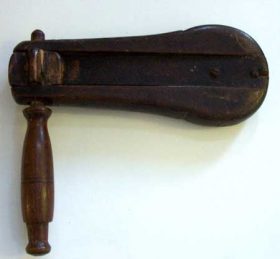
Police Rattle
Like the Rattle above, and several of those that will be pictured below, The Police Rattle has a curved shape to it that allows it to better fit the Officer's hand between the crank handle and what would become the striking end of the Rattle. Also, if we look at the crank handle we see a groove for a strap, similar to that of the thong groove found on the espantoon. Some of our Rattles still have remnants of the wrist strap that would have been used to help the officer retain the Rattle when using it either as a weapon, to signal for help, or to make hourly calls to nearby posts

Baltimore City Police Rattle
Police Officer, R. J. Brown, Badge #345
This Police Rattle once belonging to a Baltimore Police Officer, R. J. Brown, Badge #345 has a small portion of what once was a leather strap that would have been used much like that of a thong on an Espantoon was/is to retain the device either while spinning it to communicate with other officers in the area, or while swinging it as it was being used as an impact weapon to fight off an attacker, or to subdue a suspect that was resisting an arrest. The leather strap, or what is left of it, can been seen on the handle that extends from the ratchet end of this device.
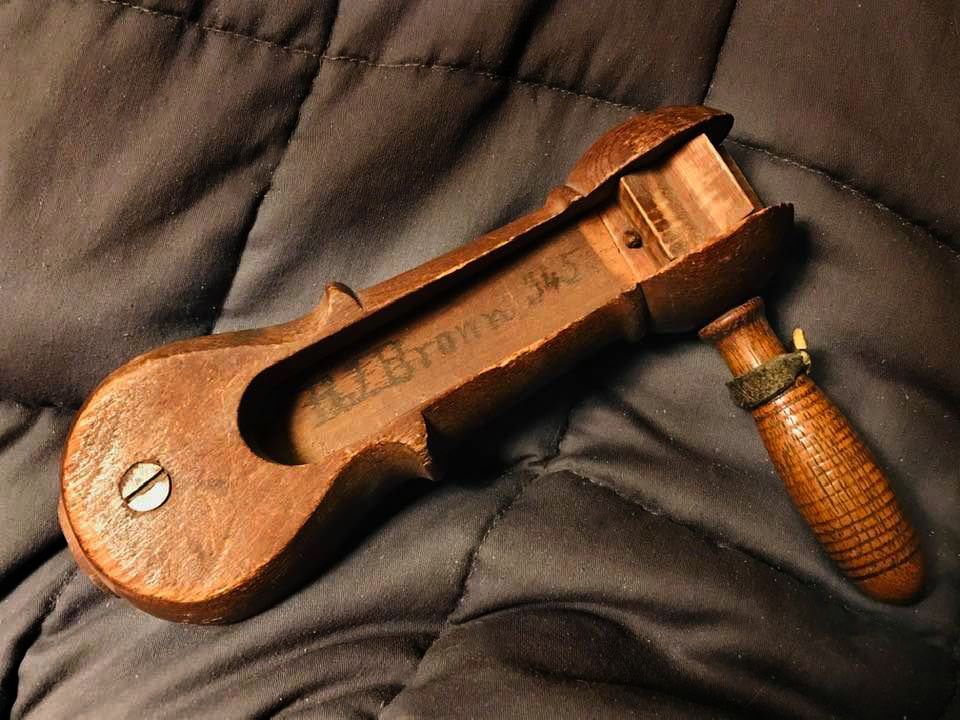
Baltimore City Police Rattle
Police Officer, R. J. Brown, Badge #345
Here we can see what appears the be the Patrolman's name and Badge number (Police Officer, R. J. Brown, Badge #345) handwritten inside this Police Rattle. We can also see the remnants of the leather strap mentioned above, as it rests on the handle. But better, we can clearly see the defining shape of the device that would have been used to help this device more comfortably fit into an officer's hand while using it as an impact weapon.


Wooden Ratchet Noisemaker
Not to be confused with a Police Rattle
In the above picture of a Ratchet we see what at first might look like an Old Police Rattle, in fact, I have seen these advertised on eBay and other internet Auction Sites listed as Police Rattles, But those with this shape, were more than likely what is known as a "Wooden Noisemaker," "Ratchet Noisemaker," or a "Party Noisemaker" that might have been used at festivities to make noise, or perhaps to make music. A wooden "ratchet" or "noisemaker" was an instrumental musical device played by a percussionist. It worked on the principle of a ratcheting device, made from a gearwheel, and stiff board, mounted to a handle. That handle was made to rotate freely as the instrument's player swung the entire mechanism around backward and forward to the rhythm of whatever song, or music they were playing.
From the straight body, and straight handle on the above Ratchet we can tell this was not meant to be held as the Police Rattle versions shown in photos above this pic. Lacking the built-in retention methods found within the natural built in shapes of the Police version Rattles this one was obviously not used for police work. While it would have easily made the sounds needed to communicate, it would not have had the effects of an impact weapon as it lacks the burl head found in the Police Rattle at the end that retains the Clapper(s) That blunt burl head that is often depended on from a Police Rattle in missing in the straight wood Ratchet noisemakers.
This version's straight shape in both the body, and in its handle, absent a groove for the retention strap is also something to avoid when trying to obtain a Police Rattle. Personally, we would probably want one of these in our collection, just to show visitors the difference, but when shopping around, keep in mind the difference is not just in what one can do that the other cannot, but also in the monetary value. A Police Rattle would hold a higher value than a simple noisemaker or musical instrument. So if you ever go shopping for one of these, Keep in mind it take more away from just preventing it from being used as a communication device, or an impact weapon once used by our police officers, watchmen, but when we find this version which was more of a musical instrument, toy, or decorative item, it also holds a much lower value.

Police Rattles & Whistles
The police whistle has its roots dating back to ancient China, where night watchmen would blow into the tops of acorns to alert the towns to invading Mongolians. In ancient Egypt two blades of the papyrus plant along the Nile River were held together in between the palms of alert security guards. By blowing into the palms the papyrus leaves would make a loud vibrant sound.
In England since the late nineteenth century Metropolitan Police Services constables have been issued with the "Metropolitan" whistle (bosun or boatswain's whistle). Prior to this, constables used hand rattles or nightsticks for signal purposes. All three were used to call for back-up in areas where neighborhood beats overlapped, and following their success in London, the whistle was adopted by most countries in United Kingdom, and around the world.

The origin of the rattle is not clear, but what has come to be known as the "Victorian Police Rattle" came into use sometime in the late seventeenth or early eighteenth century when night watchmen and/or village constables began using them to "raise the alarm". They proved to be an ideal method to summon aid, sound the fire alarm, or, just generally get folks attention. A traditional rattle was constructed of wood, usually oak, where one or two blades are held in a frame and a ratchet turned – generally by swinging – to make the blades 'snap' thus creating a very loud noise.
A typical Victorian Police Rattle can be found on display on the second floor of the Saint Paul Police headquarters building at 367 Grove Street. Not much different than the vintage ratchet style (tin w/wooden handle) Halloween noisemakers that your children use, today.
When Sir Robert Peel's Metropolitan Police was formed in 1829 the rattle was a standard piece of equipment issued to each London Bobby. Made to fit neatly into specially made pockets in the swallow tails of their coats, this rattle was one-bladed and had a folding handle. It was weighted with two lead plugs to make it swing easier and this also made it become a formidable weapon if necessary.
Rattles were used by police forces, fire brigades, and military units across the British Empire up through WW I. In 1883 the Metropolitan Police conducted tests and found that the sound from a whistle, already being used in some provincial forces, could be herd at 1000 yards – almost twice the effective distance of a rattle. Not only that, but the rattles were somewhat cumbersome, awkward to operate and prone to rot/warping. Constables were often subject to attacks from their own rattles. In 1884 whistles were issued in place of rattles and by 1887 all rattles had been withdrawn from use by the Met.
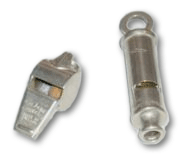 Of interesting note is the fact that the original London police whistle was the "pea whistle", and it wasn't until the early twentieth century that they switched to the air whistle, often called the "Metropolitan" or bosun's whistle.
Of interesting note is the fact that the original London police whistle was the "pea whistle", and it wasn't until the early twentieth century that they switched to the air whistle, often called the "Metropolitan" or bosun's whistle.
Early Saint Paul police officers on the beat communicated with each other with the same tools of the trade.
If a sergeant had gone over an officer's beat and was unable to find him, he would then go to its center and each extremity and tap his nightstick twice. This was known as a "call rap." The officer would answer in like manner. If the visiting supervisor required the presence of the officer, he would give a single rap. In lieu of the nightstick, a whistle could be used.
If an officer on his beat required the presence of another officer on an adjoining beat, he would, in ordinary cases, give a single rap or whistle, which would be answered in like manner. Then the officer making the call would again give a single rap or whistle in answer. In case of fire, riot or other emergency, he would give three taps or whistles in quick succession and all officers hearing it would answer by a single rap or whistle and immediately come to the assistance of the officer making the call. If an officer was in pursuit of a person at night, he was, from time to time, to give a single rap or whistle to inform other officers of his route.
Please note that the Saint Paul Police Departmental Manual of 1882 includes Rule No. 74, that states in part that when a disturbance occurs… "If he is opposed in the performance of his duty, he shall blow his whistle, and the policemen who hear it shall answer the same by forthwith proceeding to his assistance."
The Acme Thunderer metal or plastic police whistle that we are most familiar with (also called a pea whistle) contain a small light ball, called the pea, which rattles around inside, creating a chaotic vibrato effect that intensifies the sound. In Saint Paul the police whistle has been a part of the uniform almost from the beginning, and is mentioned in all of our historic police manuals.

Police whistles fell into disuse in many countries in the mid-1900s, when early hand-held radios were brought into service. With the rise of the motor car, the whistle was no longer usefully audible in urban areas. The whistle is still used by some police forces today, especially in traffic assignments, and engraved ceremonial versions are sometimes presented to police officers upon occasions such as their retirement.
Many of our retirees remember the days prior to the hand-held radios, when they went to their beat by streetcar or bus, and reported back to headquarters from "call boxes" on the corner, at least once an hour. Some of the call boxes had a light or bell on top that would warn the beat officer of an incoming message.
They also remember that the whistle was a mandatory piece of equipment brought to roll call, the same as their handgun, pocket knife, notebook, and dime. And if you checked their pockets, you'd probably find a streetcar guide and, of course, their call box key.
Many of them, also, had to work traffic details during rush hour in the various heavily used intersections. I can still hear the long single blast, meaning "stop" and the chirping sound of the whistle as the officer signaled traffic to "move on."
This article was written by Edward J. “Ed”Steenberg, Saint Paul Police Historical Society Click HERE.
Police Clap Alarm
Possible for stationhouse use
Oak Paddle
Oak board 3/4" thick, with an oak clapper on each side, when rotated back and forth in a circular motion, it causes the clappers to slap against the oak creating a loud report nearly as loud as a .22 caliber pistol firing.

Well constructed this came from a police/fire museum in R.I. where they had no further information on it.

POLICE INFORMATION
Copies of: Your Baltimore Police Department Class Photo, Pictures of our Officers, Vehicles, Equipment, Newspaper Articles relating to our department and or officers, Old Departmental Newsletters, Lookouts, Wanted Posters, and or Brochures. Information on Deceased Officers and anything that may help Preserve the History and Proud Traditions of this agency. Please contact Retired Detective Kenny Driscoll.
This email address is being protected from spambots. You need JavaScript enabled to view it.

NOTICE
How to Dispose of Old Police Items
Please contact Det. Ret. Kenny Driscoll if you have any pictures of you or your family members and wish them remembered here on this tribute site to Honor the fine men and women who have served with Honor and Distinction at the Baltimore Police Department. Anyone with information, photographs, memorabilia, or other "Baltimore City Police" items can contact Ret. Det. Kenny Driscoll at This email address is being protected from spambots. You need JavaScript enabled to view it. follow us on Twitter @BaltoPoliceHist or like us on Facebook or mail pics to 8138 Dundalk Ave. Baltimore Md. 21222
Copyright © 2002 Baltimore City Police History - Ret Det Kenny Driscoll



















 Of interesting note is the fact that the original London police whistle was the "pea whistle", and it wasn't until the early twentieth century that they switched to the air whistle, often called the "Metropolitan" or bosun's whistle.
Of interesting note is the fact that the original London police whistle was the "pea whistle", and it wasn't until the early twentieth century that they switched to the air whistle, often called the "Metropolitan" or bosun's whistle.
